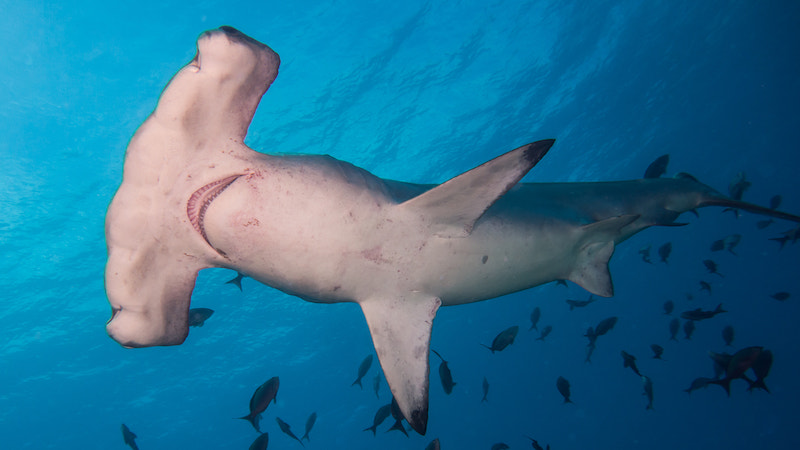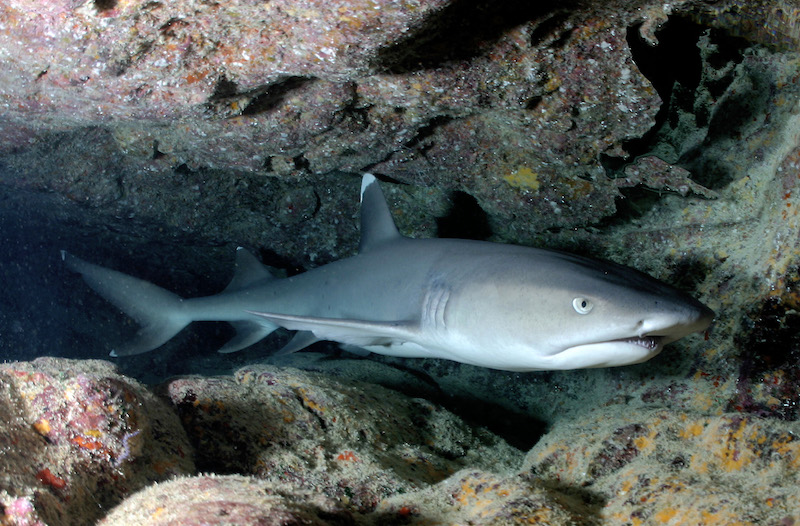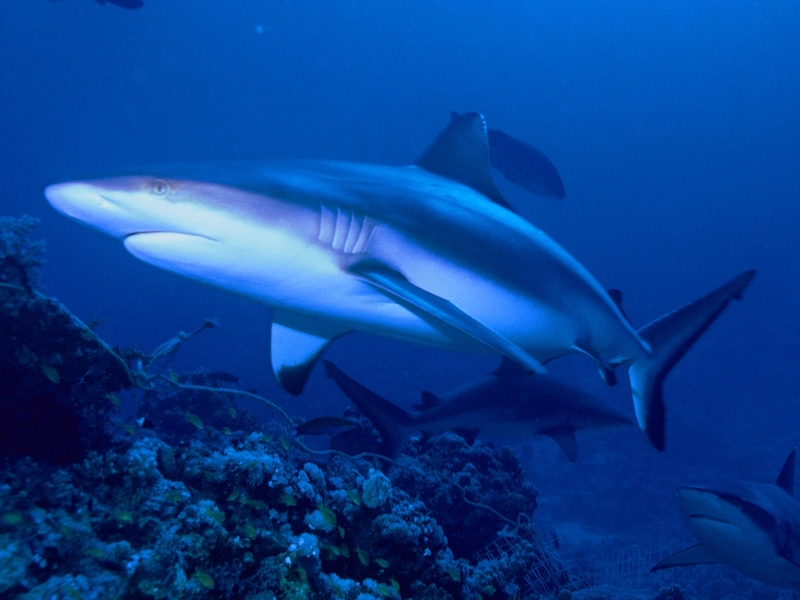Waikiki Beach is one of the most popular locations on the Hawaiian Island of Oahu, surrounded by the North Pacific Ocean.
Located in the state capital of Honolulu, Waikiki is a historic neighborhood that has several beaches and is home to most of the hotels and resorts on Oahu.
Hawaiian royalty used Waikiki Beach as a playground long ago. Today, the area is filled with attractions including the Honolulu Zoo, Waikiki Aquarium, Waikiki Historical Trail, and a wide variety of local restaurants, beachfront boutiques, and shops.
If you’re thinking of taking a vacation to Waikiki Beach, though, you might be wondering:
Does Waikiki Beach, HI have sharks? Is it safe to swim and surf in Waikiki?

Many species of sharks do frequent the waters around Waikiki, including:
- Sandbar sharks
- Scalloped hammerhead sharks
- Whitetip reef sharks
- Tiger sharks
- Blacktip sharks
- Bignose sharks
- Gray reef sharks
- And more
However, shark attacks are nearly non-existent in Waikiki, making it one of the safest places to swim, surf, and snorkel in Hawaii.
Let’s take a closer look at the types of sharks that live near Waikiki, photos, shark attack history and statistics, and more.
Types of Sharks at Waikiki, HI
According to the Department of Land and Natural Resources of Hawaii, there are approximately 40 different shark species that inhabit the waters of the Hawaiian islands.
However, only eight species are known to frequent waters near the shore.
Some shark species don’t like to inhabit shallow waters and generally aren’t seen off the coasts as they live in the lower depths of the ocean.
There are, however, four shark species that are commonly sighted near the coasts of Waikiki Beach, including:
- Sandbar sharks
- Scalloped Hammerhead sharks
- Whitetip Reef sharks
- Tiger sharks
These sharks like to live in shallow subtropical and tropical waters. Tiger sharks are generally the most aggressive species that live in Waikiki Beach waters.
There are other common inshore shark species that live in Hawaiian waters, but are less sighted. These species include:
- Blacktip sharks
- Bignose sharks
- Gray Reef sharks
Sandbar Shark

Sandbar sharks are one of the most common species sighted in Waikiki waters, as well as the Atlantic coast of the U.S. They are one of the largest coastal shark species, averaging up to 8 feet in length and weighing up to 200 pounds.
These sharks will travel as close as 30 feet below the surface and as low as 900 feet. Females tend to prefer more shallow waters compared to males, averaging about 223 feet deep. They are not commonly seen at the very surface of the water.
The sandbar shark is attracted to the waters of Hawaii because it likes to live in temperate and tropical coastal waters near islands, bays, and estuaries.
Adult sandbar sharks frequent shallow waters more than juveniles. Baby sandbar sharks will stay at deeper depths within the nursery grounds for approximately a year before venturing into shallow areas. Sandbar sharks are believed to have a lifespan of 30 years or more.
Scalloped Hammerhead Shark

Scalloped hammerhead sharks are another common Waikiki resident. Local Hawaiians refer to this shark species as mano kihikihi.
Adult scalloped hammerhead sharks frequent various bodies of water within the Hawaii islands area, including Waimea Bay, Kaneohe Bay, and Hilo Bay amongst others. Kaneohe Bay is situated off the coast of Oahu in the southwestern portion of the island.
Although they frequent shallow waters, scalloped hammerheads generally spend most of their time at depths of approximately 900 feet. Scalloped hammerheads are fairly large sharks, measuring up to 11 feet in length and weighing as much as 335 pounds.
The scalloped hammerhead shark lives in tropical and temperate waters all around the world. Much of their diet consists of small school fish, octopuses, squids, and crustaceans.
Whitetip Reef Shark

The whitetip reef shark is referred to by local Hawaiian residents as mano lalakea and is considered a guardian spirit that is well-respected.
The name of the whitetip reef shark comes from the white-colored markings that are located on the tips of their fins, as well as their preference for living near coral reefs.
Compared to other sharks, whitetip reef sharks have a relatively small home range between 0.2 and 1.8 square miles.
Whitetip reef sharks are not considered dangerous as they are not aggressive or territorial in their range.
Tiger Shark

The tiger shark is one of the top carnivorous predators that lurks throughout subtropical and tropical waters along coasts. They are commonly found along the eastern coast of North and South America.
Tiger sharks may swim at very low depths of up to 2,500 feet, but they like to spend a lot of time near the surface in shallow coastline waters.
When water is turbid, or murky, tiger sharks are very well hidden by their camouflage colors of light blueish-green.
Oftentimes it is difficult to distinguish the specific shark species that causes an attack on humans, but tiger sharks are believed to be responsible for the majority of shark attacks in Hawaii, according to the Hawaii Institute of Marine Biology.
Blacktip Shark

Blacktip sharks are known to frequent the shallow waters of the eastern coastlines of North America and throughout Hawaiian waters.
These sharks generally stay in waters less than 98 feet deep, but are also considered offshore sharks and will occasionally travel to lower depths.
They are commonly spotted by humans due to their preference to live in shallow waters, but are not considered dangerous as they are described as timid compared to other species.
Blacktip sharks can be identified by the distinct black coloration they possess on the tips of their fins, giving the shark its name. Blacktip sharks are fairly large, weighing anywhere between 66 to 220 pounds and reaching lengths up to 8 feet.
Bignose Shark

Bignose sharks are found in waters surrounding the Hawaiian islands, but they live more offshore and prefer lower ocean depths between 90 and 1,200 feet.
The size of bignose sharks can be a little alarming as they can reach lengths up to 10 feet and weigh as much as 370 pounds. However, beach goers do not need to worry about encountering a bignose shark close to shore because of their deep water habitat preference.
Bignose sharks are near threatened due to capture by fisheries, according to the International Union for Conservation of Nature. Bignose shark populations have declined rapidly in the last 60 years by up to 30% in some regions.
Gray Reef Shark

Also known as blacktail reef sharks, gray reef sharks are an offshore shark species that live at an average depth of 320 feet below the ocean’s surface.
Gray reef sharks are not very common in Waikiki Beach waters. Gray reef sharks predominantly occupy the Northwestern Hawaiian Islands waters, rather than the southeastern islands where Oahu is located.
Gray reef sharks are known to congregate in large groups of up to 100 sharks and prefer coral reef habitats. They do not stray far from their home range, which is generally 1.6 square miles.
The biggest threat that the gray reef shark poses to humans is to divers in deeper waters.
Gray reef sharks are very curious and will often approach divers in their habitat. Gray reef sharks are considered dangerous to humans as they may become aggressive when they feel threatened.
(Worried about jellyfish in Waikiki? Click here.)
Shark Attack History at Waikiki (Statistics)
Waikiki is actually one of the safest beaches in Hawaii to enjoy swimming, surfing, paddle boarding, and other water activities.
Although there are occasional shark sightings, Waikiki Beach has only had one shark attack that was officially reported by local news.
The account of the shark attack involved a local Waikiki man who had been bitten on the foot by an unidentified shark sometime in 2015.
There was a recent shark encounter by a surfer in May 2019 in Waikiki. The surfer was unharmed as the shark only bumped him off his surfboard, which is not an uncommon occurrence between surfers and sharks.
The Hawaii Department of Land and Natural Resources have kept records of shark incidents since June 1995, which are exclusive to accounts of when people have been bitten by a shark.
The records do not include sightings or encounters that did not involve a bite.
On the shark incident list, there are no records of shark attacks in Waikiki as of March 2022.
The most recent attacks have taken place in Kailua-Kona, where two shark attacks were recorded in February and March 2022, approximately 1 to 1.5 miles from the shore.
Maui is considered the most dangerous island where most shark attacks occur of all Hawaii islands and beaches. Since 1995, more than 55 shark attacks have taken place in Maui.
October is considered the most common time for a shark attack to occur in Hawaii, with the most shark attack incidents occurring during this month compared to other times of the year. However, a large majority of these incidents were not fatal.
Wrapping Up
Although there are sharks that frequent the shallow coastal waters of Waikiki Beach, this area of Hawaii is extremely safe in relation to shark attacks compared to other Hawaii beaches and islands.
Shark sightings do occur in Waikiki, but shark attacks in this area are almost nonexistent.
Therefore, you can enjoy your Waikiki Beach vacation without being overwhelmed with worry that a shark may attack you as it’s extremely unlikely!
For more guides, check out:
Hope this helps!